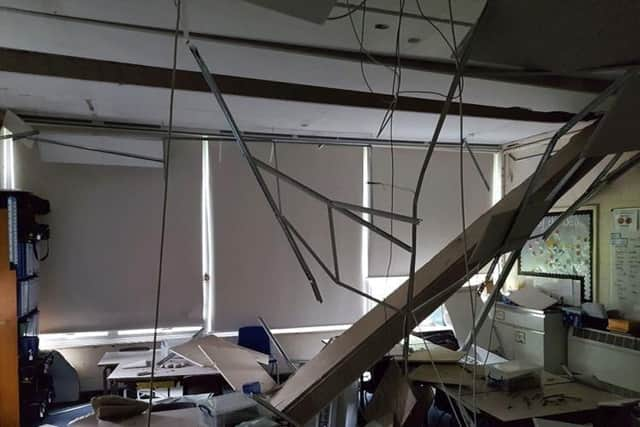What is RAAC? Why was the concrete used to build schools and hospitals across much of Scotland?
The dramatic closure of more than 100 schools in England has thrust RAAC to the top of the political agenda in the past few days, both north and south of the border.
Rising concerns about the concrete construction material have led to questions over the safety of public buildings across the UK.
Advertisement
Hide AdAdvertisement
Hide AdAs emergency contingency plans are drawn up, decision-makers are facing intense scrutiny over their response to the crisis, locally and nationally.


With details continuing to emerge, The Scotsman has been finding out about RAAC and its dangers.
What is RAAC and how is it made?
RAAC stands for reinforced autoclaved aerated concrete. It is a form of autoclaved aerated concrete (AAC), which is different from normal dense concrete. It is “bubbly” and relatively weak.
AAC has no coarse aggregate, and is made in factories using fine aggregate, as well as chemicals to create gas bubbles, and is heated in an autoclave. When it is reinforced to form structural units AAC becomes RAAC. A bituminous or a cement latex coating is applied to the reinforcement prior to casting the planks.
Reinforcement mesh is then introduced into the formwork and the liquid AAC mix is added, according to the Standing Committee on Structural Safety (SCSS).
What was it used for and when?
AAC was first developed in Sweden in the 1920s and was mainly used for the construction of lightweight thermal blocks. The reinforced version, RAAC, was subsequently introduced and widely used in the UK from the 1950s to the mid-1980s.
It was generally used for wall panels or roof planks, in the construction of government estate buildings, including hospitals and schools. RAAC is still used in other parts of the world and modern versions can be safe.
Why was it used in construction?
Because it was relatively lightweight, which made transportation, lifting and handling easier, and reduced the load to supporting structures and foundations.
Advertisement
Hide AdAdvertisement
Hide AdIn addition, RAAC had good thermal properties and good fire resistance, according to a report to West Lothian Council, which was one of the first authorities to carry out repairs to remove RAAC in Scotland.
It said the disadvantage of RAAC planks were they are susceptible to moisture and water, which can cause corrosion of the embedded reinforcement.
RAAC also does not bond adequately to the reinforcement, which results in the planks being more susceptible to deflection or sagging, and to the risk of shear failure occurring at the supports.
When did concerns about RAAC begin to emerge?
The SCSS has stated that by the 1980s, there were many instances of failure of RAAC roof planks installed during the mid-1960s, and a large proportion of such installations were subsequently demolished.
Widespread use of RAAC in public buildings ended in the UK in the 1990s, after further inspections found excessive deflection and cracking in RAAC roofing planks and corrosion to reinforcements.
In 2018, the collapse of a roof at a school in Kent was highlighted to local authorities in England by the Local Government Association (LGA) and the Department for Education. The following year, in 2019, an alert was issued by the SCSS.
It said: “The useful life of such planks has been estimated to be around 30 years. Pre-1980 RAAC planks are now past their expected service life and it is recommended that consideration is given to their replacement.”
In September 2022, the Office of Government Property sent a safety briefing notice to all property leaders, stating: “RAAC is now life-expired and liable to collapse”.
Advertisement
Hide AdAdvertisement
Hide AdWhy didn’t public bodies take action earlier?
Many did. A lot of schools and other buildings containing RAAC have been replaced over the years, and several authorities carried out early surveys to identify where it was located.
In Scotland, West Lothian Council had found RAAC and had begun drawing up plans to repair or replace several buildings more than two years ago, while the Scottish Fire and Rescue Service (SFRS) identified issues at 14 of its sites in 2019 and carried out temporary reinforcement of structures.
NHS boards in Scotland were also told to survey their estates for RAAC in February this year.
The Scottish Government previously distanced itself from repair work, saying that health and safety legislation was not devolved, with the Health & Safety Executive, instructed by the UK Government, acting as the UK-wide regulator for health and safety. It also emphasised that local authorities were responsible for managing and maintaining schools.
What is being done now?
First Minister Humza Yousaf said on Saturday that Scottish ministers had no plans to close affected schools “at this stage”.
The Government has also said that checks are ongoing in buildings thought to contain RAAC, but some of it “takes time to carry out”. There are also questions about scale of RAAC in NHS sites, with 250 buildings thought to contain the material.
The Holyrood Government has established a cross sector working group on RAAC to “ensure action is taken where required so that people are safe and feel safe in buildings”.
Work to repair and replace buildings will also cost many millions of pounds.
Advertisement
Hide AdAdvertisement
Hide AdChancellor Jeremy Hunt has said the UK Government would “spend what it takes” to resolve the issue, which would be likely mean a uplift in the Scottish budget under the Barnett formula.
However, councils have already been left in limbo over work on new schools, with a long-awaited spending announcement from the Scottish Government having already been repeatedly delayed.
Comments
Want to join the conversation? Please or to comment on this article.
